As Maharashtra joins other Indian states in ban on use of gestation and farrowing crates on pig farms, it moves one step closer to modernising infrastructure that farmers hope will give them a shot at competing with top contenders like Assam and Nagaland
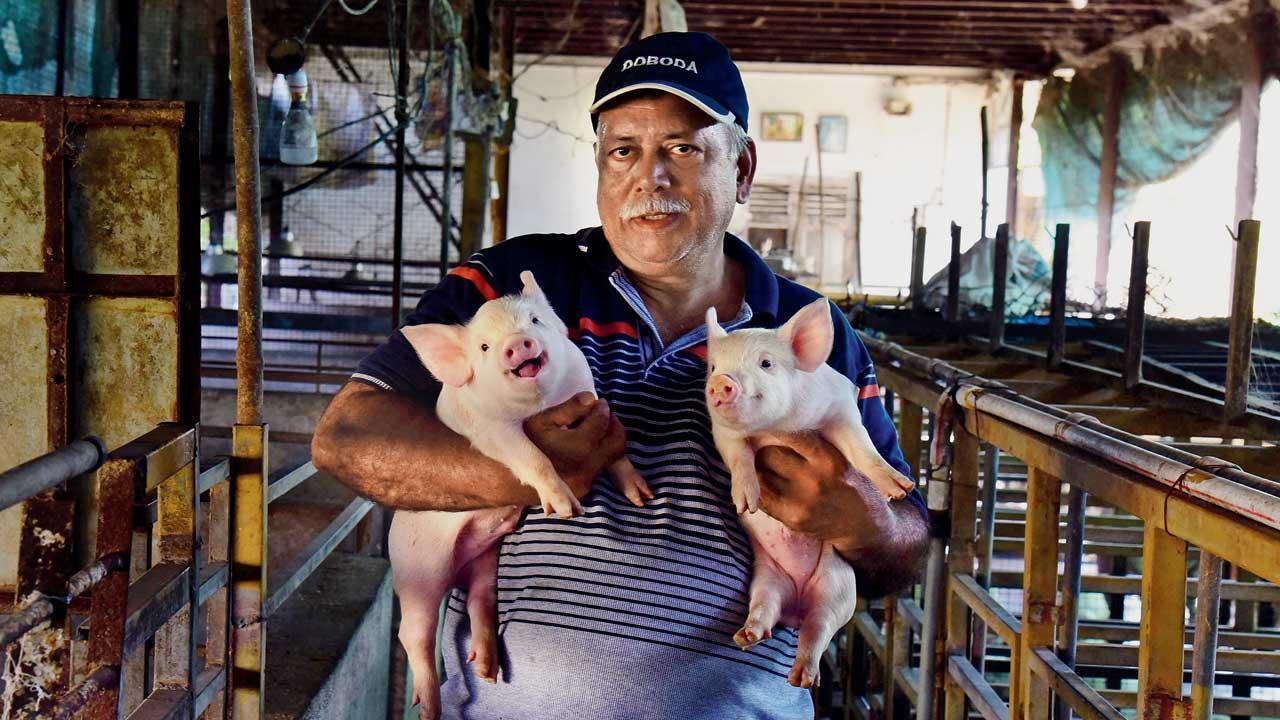
Valerian Fernandes holds up two young pigs at a farm set up on his land in Vasai by Gargi Genetics Pvt Ltd in Vasai. GGPL has since 2019 been working towards turning pig farming in Maharashtra from a backyard project into an organised industry through scientific breeding and modern amenities. Pic/Nimesh Dave
The April morning is not deterring Valerian Fernandes from standing over a coal furnace, lovingly stirring a mixture that’s bubbling in a large pan. “It has gram, rice husk, special calcium and vitamin supplements; all the goodness the babies need.”
ADVERTISEMENT
The ‘babies’ are piglets, around 70 of them aged between one and five months. The adult inhabitants of Gargi Genetics Pvt Ltd’s (GGPL) pig farm in Vasai include three full-grown sows and two boars. This is one of four farms the firm runs in Maharashtra.
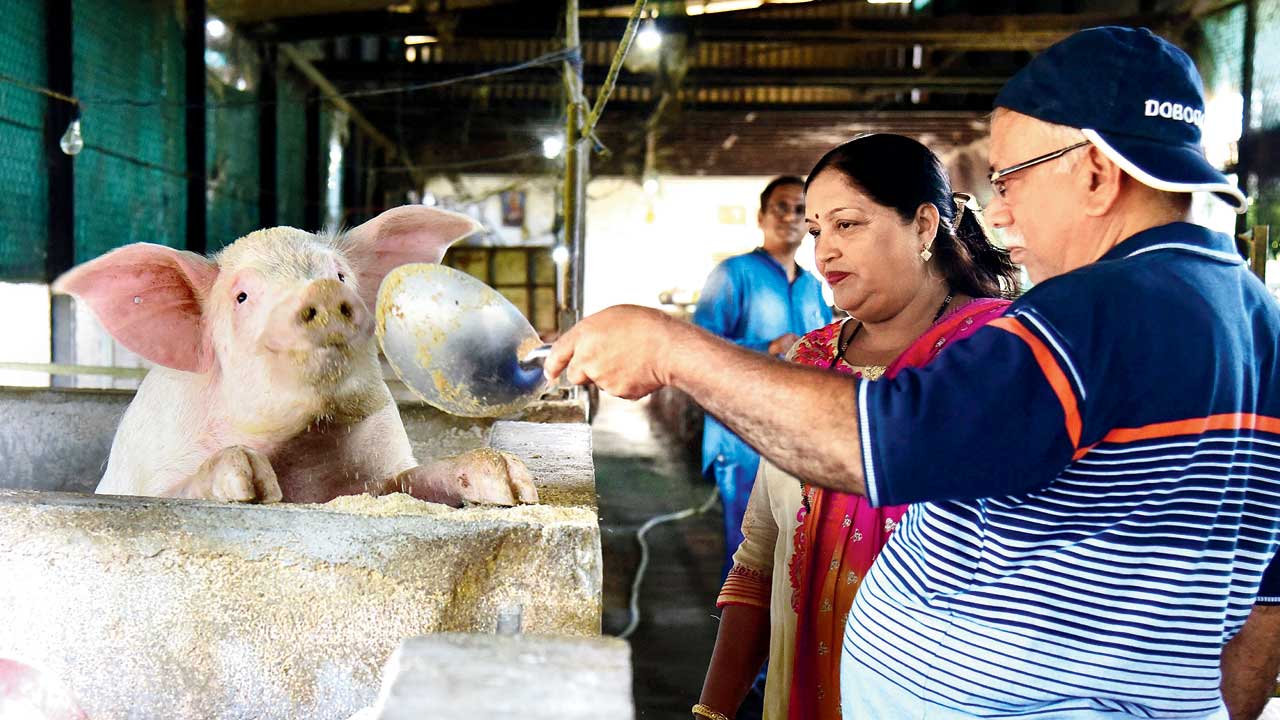 Valerian and Regina Fernandes feed one of their ‘babies’ at the Gargi Genetics Pvt Ltd farm in Vasai. Set up by Sandeep Mestry, a Chartered Accountant, and Dr Nitin Malekar, a geneticist, GGPL partners with pig farmers in Maharashtra, providing funding and technical know-how to develop the state’s formerly disorganised pig farming industry. From just the Vasai farm, GGPL sends 120 pigs every month to Northeast India; the biggest Indian market for pork today. Pics/Nimesh Dave
Valerian and Regina Fernandes feed one of their ‘babies’ at the Gargi Genetics Pvt Ltd farm in Vasai. Set up by Sandeep Mestry, a Chartered Accountant, and Dr Nitin Malekar, a geneticist, GGPL partners with pig farmers in Maharashtra, providing funding and technical know-how to develop the state’s formerly disorganised pig farming industry. From just the Vasai farm, GGPL sends 120 pigs every month to Northeast India; the biggest Indian market for pork today. Pics/Nimesh Dave
Six years ago, the campus had two full grown pigs and a couple of piglets roaming in the open space; the operation had no discipline or structure. When GGPL stepped in, its director Sandeep Mestry launched a revamp. “We brought in Yorkshire and Landrace boar so that they could mate with the sows and produce healthy piglets, and we renovated the lodging facility,” Mestry recalls, describing his partnership with Fernandes. The land belongs to the latter while GGPL manages the operations and the two split the profits.
Pig farming in Maharashtra is a developing industry. States like Assam, Meghalaya, Jharkhand and West Bengal stand at the forefront. Maharashtra is still in the process of shedding the stigma attached to pig rearing. For long, pigs have been considered ‘dirty’, their rearing, the domain of the illiterate and poor; consuming pork is a concept associated with either ‘cultureless foreigners’ or tribals.
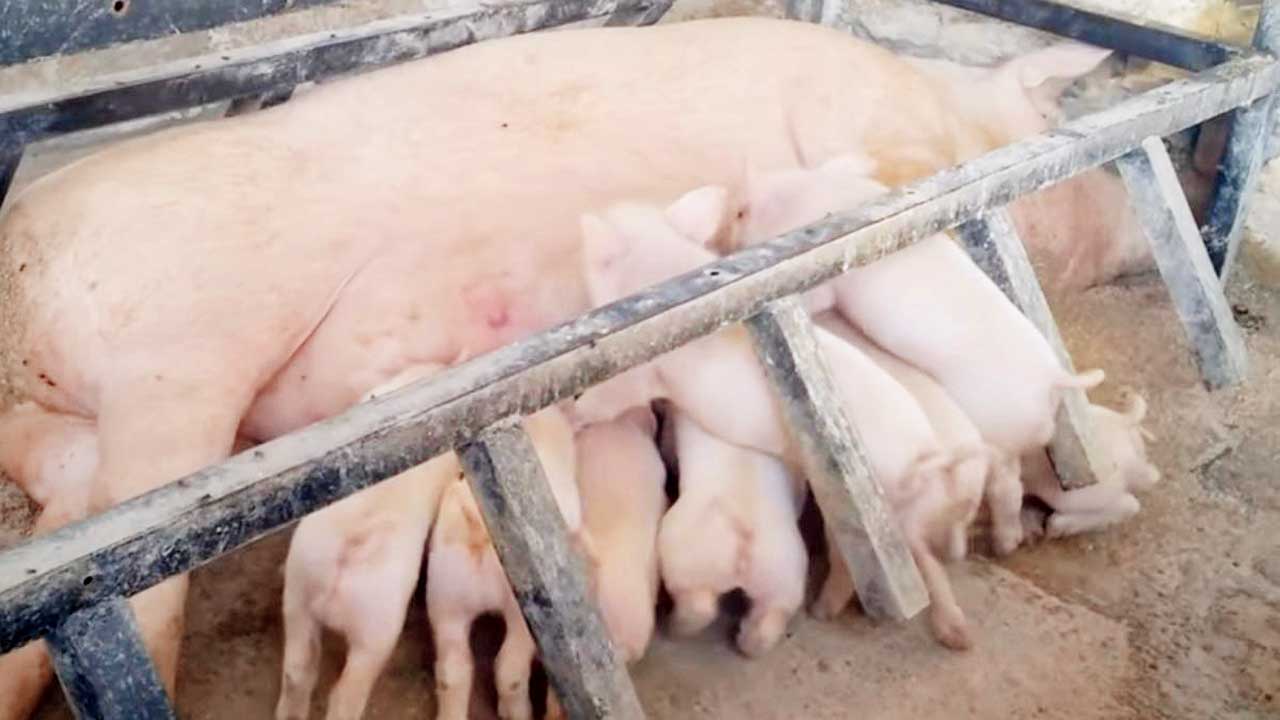 A sow with her piglets in a farrowing crate. Sows spend their entire pregnancy in restrictive gestation crates and are later moved to farrowing crates, which are not much larger but allow for the piglets to suckle. Pic courtesy/PETA
A sow with her piglets in a farrowing crate. Sows spend their entire pregnancy in restrictive gestation crates and are later moved to farrowing crates, which are not much larger but allow for the piglets to suckle. Pic courtesy/PETA
In 2018, a pilot project named Rashtriya Krishi Vikas Yojana (RKVY) launched by the Ministry of Agriculture and Farmers Welfare was designed to train 100 farmers from Maharashtra in pig farming, in order to give a boost to the industry, institute scientific breeding methods and create earning opportunities. But disinterest stared them in the face. Despite planting daily advertisements in farming-related publications, they did not receive a single application. The RKVY then placed advertisements in daily newspapers. They received interest from just one candidate: a landless labourer from Gadchiroli in eastern Maharashtra.
“This man said that pig rearing was mostly carried out in the area by the marginalised communities, and he was reluctant to travel to Satara [where the training had been initially planned]. We decided to move the training centre to Gadchiroli,” reads the RKVY’s report compiled by Dr Hemant Birade, Associate Dean, Post Graduate Institute of Veterinary and Animal Sciences.
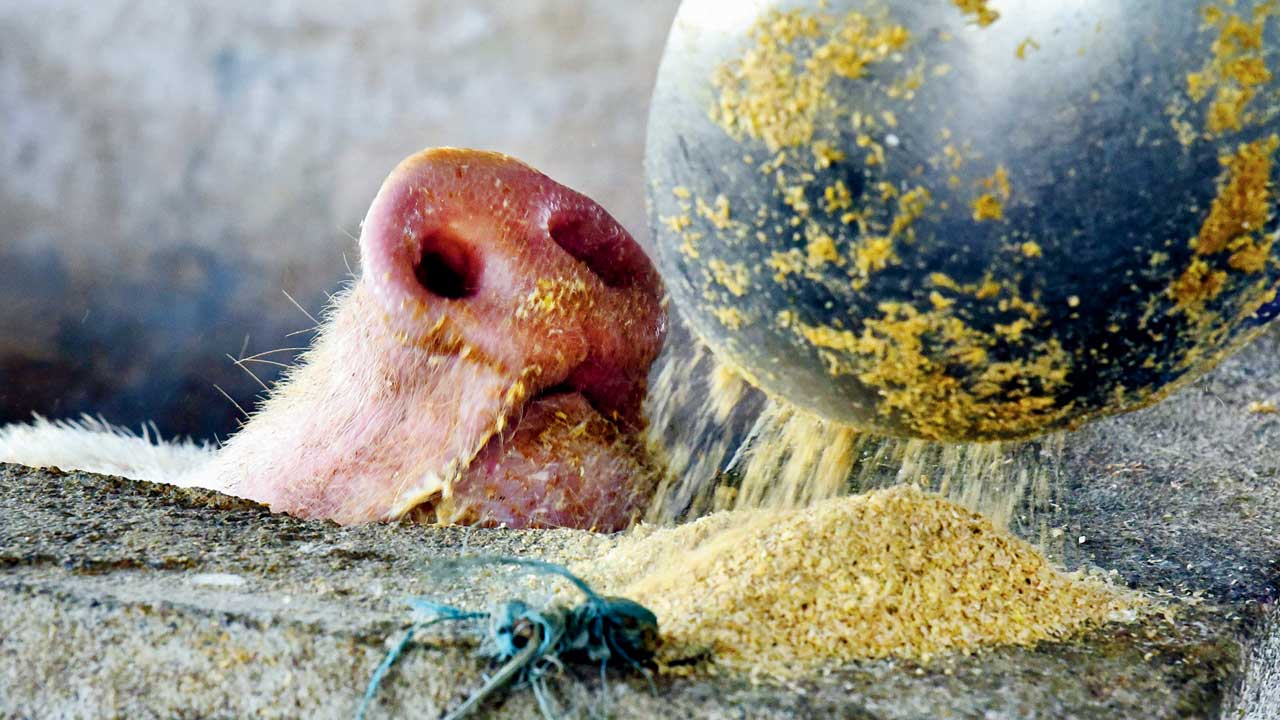 The pigs at GGPL are fed a special mix of grams, rice husks and nutritional supplements that ensure a healthy batch and the best quality of meat
The pigs at GGPL are fed a special mix of grams, rice husks and nutritional supplements that ensure a healthy batch and the best quality of meat
A model farm was created of large white Yorkshire and Duroc breeds. Fifty pigs were purchased from Kerala Veterinary College, Mannuthy, to rear. The training was completed and each farmer received a two to three-month-old female and one male piglet. Following the training, several pig farmers launched mini businesses, but it was far from smooth sailing. Two farmers from Kolhapur, who received a positive response from buyers thanks to their proximity to Goa, where pork is part of the daily diet, faced threats and harassment from fellow villagers, the report states. It would be a while before this could become an organised business. Marginalised families rearing a pig or two in a pigsty or small patch of land adjacent to their homes in the outskirts of villages, and feeding them on hotel or kitchen waste, continued. No attention was paid to the nutrition of the pigs or medical care. Since the market for pork in Maharashtra was restricted, the status quo prevailed. GGPL’s entry since 2019 and the setting up of farms in Vasai, Wada, Nagpur and Kolhapur has helped launch an ecosystem of sorts. Today, from its Vasai farm alone, a container of 120 pigs is ferried across to the Northeast, once a month, excluding three months in the summer when heat is at its peak and people prefer to avoid red meat.
GGPL has also established buy-back partnerships with around 50 pig farmers in the Palghar district, where the farmers buy newborn piglets from GGPL’s farms, rear them for upto six months while following due precaution and procedures, and sell them back to GGPL at a higher price.
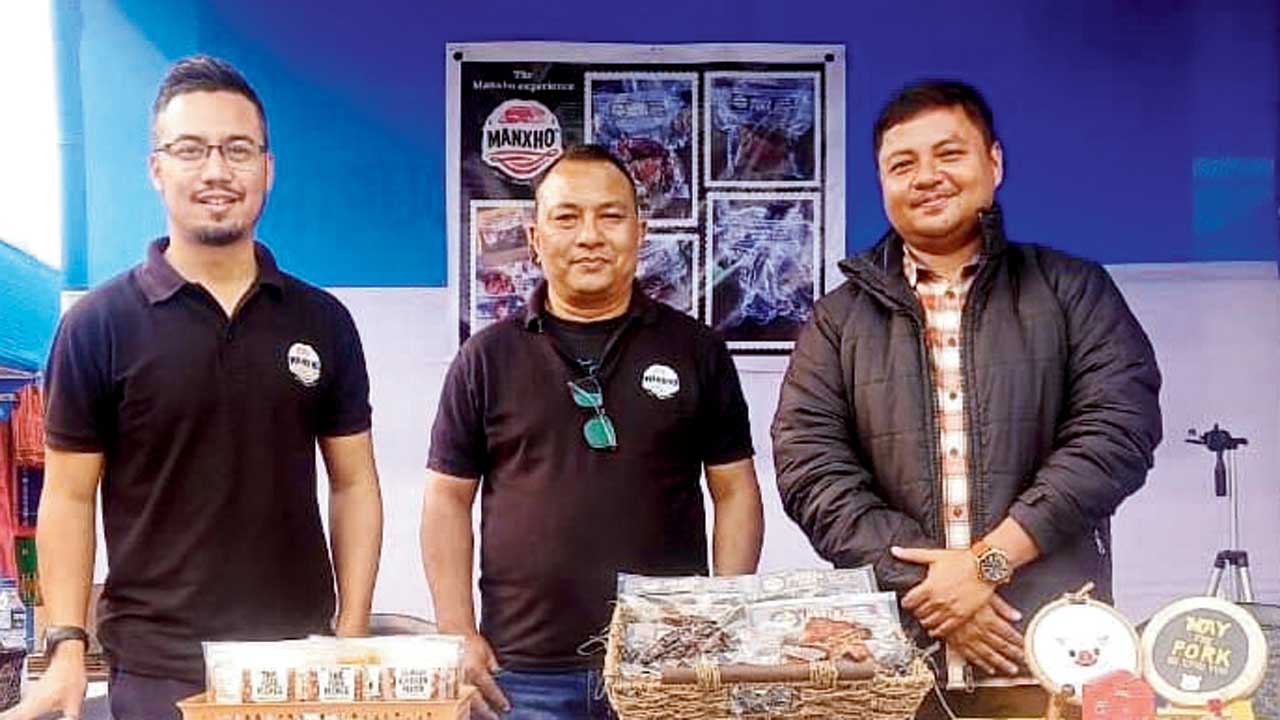 Manxho founders Diganta Saikia, Vardaan Saikia and Jitu Bora
Manxho founders Diganta Saikia, Vardaan Saikia and Jitu Bora
According to a November 2022 report published by A Minhas of Statistia, the total consumption of pork in India in 2022 was a little over 2,94,000 metric tons, and this is a gradual decrease over the years. The majority of the pig population in India is distributed along the central and northeastern belt of the country. In 2019, Assam, at over two million, had the highest number of pigs in India.
Due to the high demand, the northeast region also ranks high in pork production volume. In 2015, Assam and Nagaland alone produced around 117 thousand metric tonnes of pork. Meanwhile, in 2018, over 500 metric tonnes of pork were imported into India, while around 270 metric tonnes were exported, the report states.
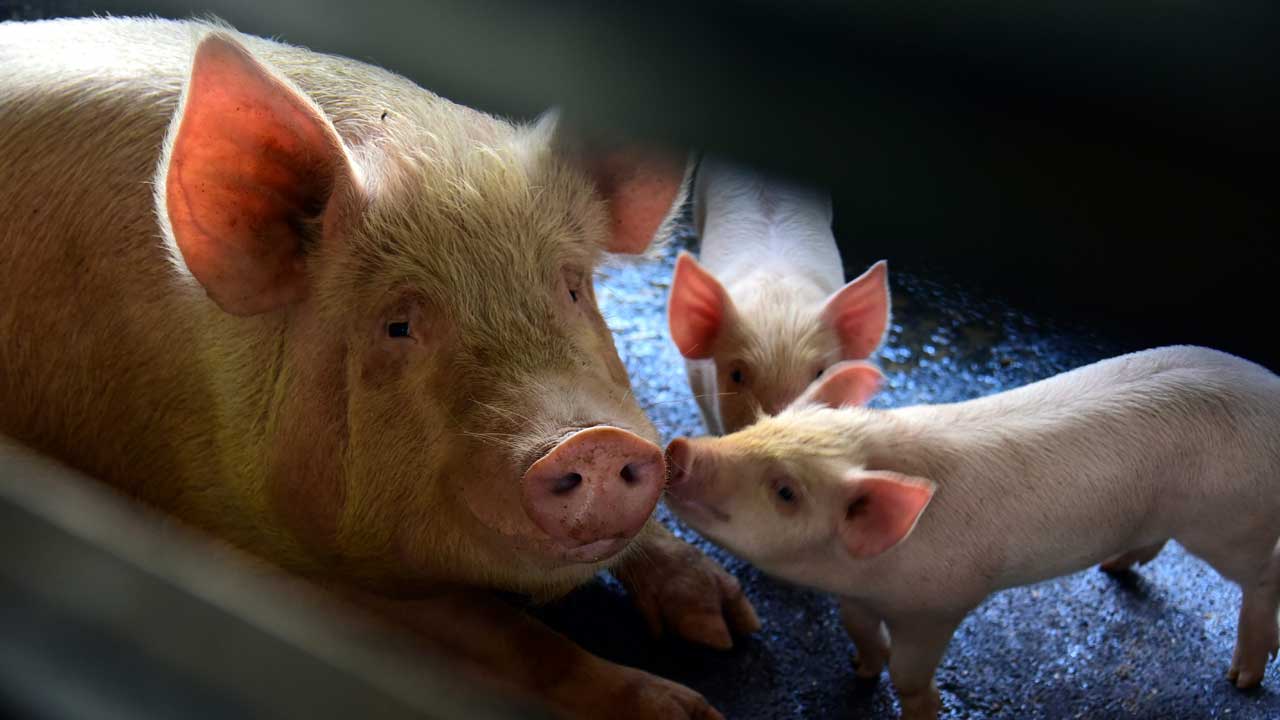 At the GGPL pig farm, sows that have just given birth are lodged in larger enclosures along with their offspring. These enclosures have metal bars the piglets can nestle behind on sensing their mother is about to keel over from sleepiness
At the GGPL pig farm, sows that have just given birth are lodged in larger enclosures along with their offspring. These enclosures have metal bars the piglets can nestle behind on sensing their mother is about to keel over from sleepiness
Currently, Indian pork sells for R450 per kilogram if bought from a supplier at the GGPL level and the price can go down to Rs 250 per kg, depending on how small the supplier is.
Direct to customer platforms have seen encouraging sales in the recent past. Manxho, a startup based in Dibrugarh district of Assam, began operations in June 2020 and now caters to clientele pan-India, including cities in Maharashtra. Diganta Saikia, one of the three co-founders, says that it hasn’t been easy, with the African Swine Fever and the stigma around pig meat, which exists across the country, including in some parts of northeast India. “The fever killed almost 300 of our animals and despite having started in June, we had to temporarily suspend operations in November 2020. Luckily, the pan-India market wasn’t affected as much as it was in the northeast. We now procure all our meat from local farmers. Apart from the northeast which forms 80 percent of our customer base, we also deliver to Mumbai, Pune, Nagpur and Nashik.”
 Sandeep Mestry; Farhat Ul Ain and Nikunj Sharma
Sandeep Mestry; Farhat Ul Ain and Nikunj Sharma
Gurgaon-based startup Meatigo has also seen a steady increase in demand as well as sales value. “If one were to evaluate demand, pork meat consumption in India is low compared to other proteins. Even if we were to benchmark pork consumption in India vis a vis some international markets like Europe and East Asia, India is under indexed. Logically so, as the country has a vast coastline with easy and affordable access to seafood, and it loves its white meat like chicken. On a per capita basis, pork consumption would be 0.5-0.8 kg in India versus 4-5 kg of chicken and fish. Having said this, with rising awareness and availability of cleaner meats from select farms, selective breed sourcing by brands and the trend of Indians travelling and being exposed to different meats, pork consumption in India is growing,” says co-founder Siddhant Wangdi.
Quality meat is the result of modernisation in rearing. “The earlier hesitation towards buying pigs reared in Maharashtra was not without reason. Roaming around in filth, eating hotel waste and the complete absence of medical attention produces inferior quality meat. It’s hardly surprising that the pigs found no takers,” says Dr Nitin Malekar, a geneticist who is also a director at GGPL. “Pigs need regular vaccination and a clean environment to ward off infections. Organised segregation of the animals is also mandatory to prevent mishaps since this is a restless species. Their canine teeth need to be sawed off before they turn one-month-old, since these are the sharpest. They need nutritious food and plenty of water to drink.”
 Dr Nitin Malekar, geneticist
Dr Nitin Malekar, geneticist
The mix of grains and supplements that Fernandes prepares every day is not just healthy but tasty too; it’s why the animals eat it willingly. Fernandes has a young boy to help him, who tastes the mixture for salt and spices before it can be given to the pigs. Dr Malekar compares the mixture to the quintessential Indian comfort food; dal khichdi.
But, for all their enthusiasm—Mestry is a chartered accountant who took to pig farming out of passion, and Malekar holds a PhD in genetics and runs an early stage cancer detection clinic—progress hasn’t been swift. They say that their biggest hurdle is bureaucracy. Four years after they started their passion project, GGPL still hasn’t received the one thing they have been trying hard to acquire: a government licence to import foreign breeds. Indian pig breeds are considered unfit for high-quality pork production.
“We have a Canadian gentleman eager to partner with us and have species from there that are conducive to Indian conditions and weather mate with our sows and produce robust, high quality offspring. This requires an import licence. We have made so many rounds of government offices that even the peons know us by name. But we have seen no help,” Dr Malekar laments.
In states like Maharashtra, which is not at the forefront of pig farming, competition is cut throat. On December 20, 2022, Vasai resident and pig farmer Harjeet Singh was on his way home when a pick up truck crashed into his car. The three men who exited the truck were armed with swords and at least one of them had a handgun. The trio forced Singh out of his vehicle, assaulted him, forced him into the truck and sped off. However, in the face of Singh’s resistance, the assailants abandoned the truck, with Singh and their weapons inside, and fled on foot.
The Waliv police, who went on to register an FIR of attempt to murder against unidentified persons under the Indian Penal Code, also found a few pigs inside the same truck. Subsequent investigations indicated that the assailants were connected to a group that owns a pig farm next to Singh’s. The case is still being probed.
Complicating matters is the debate currently raging over the pros and cons of using gestation and farrowing crates on pig farms, a practice that’s been termed cruel by activists but deemed essential by those in the industry.
Gestation crates are cages measuring around seven feet in length and two feet in breadth, barely larger than the size of an average adult pig. Pregnant sows spend their entire term of 113 days inside these cages, unable to move freely till they deliver their litter. As soon as they give birth, they are moved to farrowing crates, which are cages of the same size as gestation crates, but with an attached enclosure where the newborns are placed. The piglets suckle through the bars of these crates till they are healthy enough to be moved out.
In August last year, the Commissionerate of Animal Husbandry, Maharashtra, which is based in Aundh, Pune, issued a circular stating that those using these crates were liable for action under the Prevention of Cruelty to Animals Act. The circular was based on repeated appeals by the global non-profit People for Ethical Treatment of Animals (PETA) as well as a Right To Information reply that PETA received from the Indian Council of Agricultural Research–National Research Centre on Pig (ICAR-NRCP). “We had sent an RTI query to the ICAR-NCRP in 2021, asking if the crates were illegal under the PCA Act and whether the NCRP actively recommends and promotes their use in India. The response we received was that under section 11(1) of the Act, whoever confines any animal in a cage or receptacle that does not measure sufficiently in height, length and breadth to permit the animal any reasonable opportunity for movement shall be punishable. They further stated that they do not have any programme to recommend or promote the crates in India,” Farhat Ul Ain, Advocacy Associate, PETA, tells mid-day.
The Commissionerate’s letter, subsequently, termed the use of the crates illegal under the same section, which attracts a fine in case of a first offence, and a higher fine with imprisonment of up to three months if a second offence is registered against the same person within three years of the first.
“Our circular empowers the local district administration to take action against the offenders, with the District Collector being responsible to oversee this. As with other offences under the PCA Act, the local police can prosecute offenders found to be using gestation and farrowing crates,” says Dr Shailesh Kende, Deputy Commissioner, Animal Husbandry, Maharashtra.
Dr Kende, however, admits that the Commissionerate does not keep track of action taken under the Act.
“As this is under the local administration’s purview, the data will be available with them, as is the case with all offences registered in a particular district under various laws and acts,” he adds.
PETA and Mercy For Animals India, the Indian arm of an international animal rights organisation, have for years been advocating the abolition of this practice. “In the absence of space to move around, and unable to properly care for their offspring, the pigs go through terrible physiological and psychological trauma. Further, they have to sit in their own urine and faeces for hours, leading to infection. The meat of such pigs is not very healthy to eat. In their natural surroundings, pigs are social, playful, protective animals who bond with their babies, make nests for themselves, relax in the sun and cool off in the mud. But on pig farms, they’re denied everything that is important to them,” argues Farhat.
Following repeated appeals by PETA and Mercy For Animals India, since 2022, 18 Indian states and union territories have issued similar circulars prohibiting the use of both gestation and farrowing crates in pig farming, with Maharashtra becoming the 19th. These include Andhra Pradesh, Chhattisgarh, Delhi, Goa, Gujarat, Himachal Pradesh, Karnataka, Madhya Pradesh, Manipur, Meghalaya, Mizoram, Punjab, Rajasthan, Sikkim, Telangana, Uttarakhand, Uttar Pradesh
and West Bengal.
“Pregnant and nursing sows confined in gestation and farrowing crates don’t have enough space to even turn,” says Nikunj Sharma, Chief Executive Officer at Mercy For Animals India. “As a result, the pigs suffer bone degeneration and show signs of extreme stress, including biting the metal bars of their crates. We are grateful to the government of Maharashtra for this decision.”
Mestry, however, points out that the crates are not as inhospitable as they are made out to be. When this writer visited the GGPL farm in Vasai, all the farrowing crates that the sows were lodged in had a good two to three feet of free-space space lengthwise, were partially open from above and had spigots installed in the front, through which the sows could drink water. The sows were trained in their use and clamped their teeth on the spigot whenever thirsty, which saved water as compared to the traditional practice of placing buckets full of water in open spaces.
“Thirty years ago, we could remember phone numbers by heart. The advent of mobile phones changed that. This is not by choice but because when a need is eliminated, our system automatically sheds certain practices. Pigs are very similar to human beings. In a forest, all their senses are on high alert. But in a setting where they are getting food and care in one place, they become relaxed. Sows are especially low on awareness right after giving birth. They can tumble over and crush their own offspring, or even eat them since birthing makes them hungry and the piglets are covered in blood,” says Mestry, explaining why crates have their own use.
This writer observed that at the Vasai farm, sows who had just delivered a litter were lodged along with their offspring in larger concrete spaces, with metal bars along the inside edges.
“As soon as the piglets sense that their mother is sleepy, they slide behind the bars and the mother lies down. Every space or crate is cleaned every day of urine and faeces. Nobody would be sadder than us if our pigs fell ill,” explains Dr Malekar, adding, “We need to realise that food and water are going to be the biggest issues we will face in the future and pork is among the most nutritious meats and sources of protein that we can capitalise on. Plus, let’s consider the revenue and the employment opportunities that an established pork and pig-products industry will generate.”
37gm
Amount of protein 100 grams of high quality pork yields, making it a cheap source of nutrition
The success story

Apart from the organised players like GGPL, there are myriad small-scale pig farms that are springing up all over the State, particularly in areas like Pune. Thanks to programmes like the RKVY’s training sessions, independent farmers are slowly but surely making progress, while the more established ones are helping the newbies along.
Gopal Sural, who has been running the Gowardhan Pig Farm in Pune since 1999, was one of the instructors at the 2018 training campaign, where those wishing to start their pig farms were trained in the rearing and medical care of the animals. Today, the independent farmers buy the parent pigs from Sural, who also provides free lifetime consultation to them.
“Smaller players like the ones I work with hardly get more than R100 per kg in the local market, and hence, we combine a batch of around 10 to 20 tons and send it to the North East at a single time. This is the only way we can earn a profit as the cost is higher there and covers our expenses towards logistics and other aspects,” says Sural.
 Subscribe today by clicking the link and stay updated with the latest news!" Click here!
Subscribe today by clicking the link and stay updated with the latest news!" Click here!







